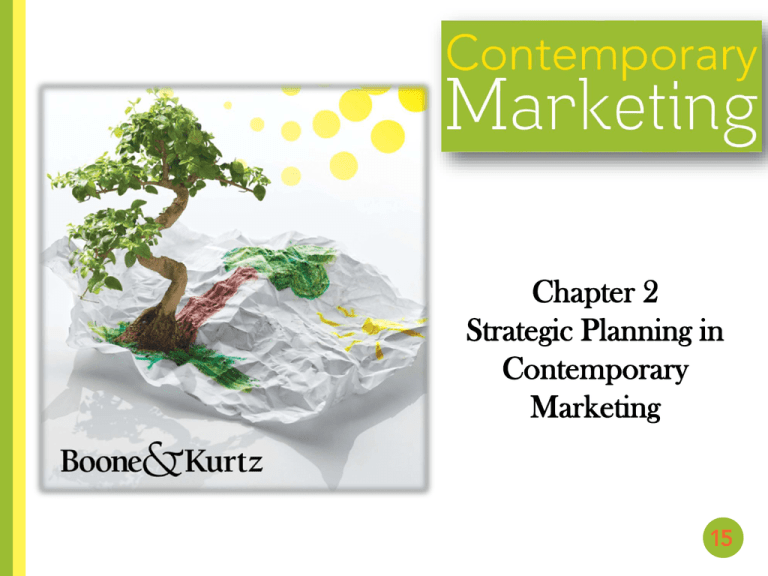
Chapter 2
Strategic Planning in
Contemporary
Marketing
CHAPTER 2 Strategic Planning in Contemporary Marketing
Chapter Objectives
1. Distinguish between strategic planning and tactical planning.
2. Explain how marketing plans differ at various levels in an
organization.
3. Identify the steps in the marketing planning process.
4. Describe successful planning tools and techniques, including
Porter’s Five Forces model, first and second mover strategies,
SWOT analysis, and the strategic window.
Copyright © 2012 by South Western, a division of Cengage Learning. All rights reserved.
CHAPTER 2 Strategic Planning in Contemporary Marketing
Chapter Objectives
5. Identify the basic elements of a marketing strategy.
6. Describe the environmental characteristics that influence
strategic decisions.
7. Describe the methods for marketing planning, including
business portfolio analysis and the BCG matrix.
Copyright © 2012 by South Western, a division of Cengage Learning. All rights reserved.
CHAPTER 2 Strategic Planning in Contemporary Marketing
Marketing Planning: The Basis for Strategy
and Tactics
o Planning - Anticipating future events and
conditions and determining the best way to achieve
organizational objectives
o Continuous process; creates a blueprint for everyone in
the organization
Copyright © 2012 by South Western, a division of Cengage Learning. All rights reserved.
CHAPTER 2 Strategic Planning in Contemporary Marketing
Marketing Planning: The Basis for Strategy
and Tactics
o Marketing planning - Implementing planning activities
devoted to achieving marketing objectives
o Many planning activities take place over the Internet
with virtual conferences
o An important trend in marketing planning centers on
relationship marketing
Copyright © 2012 by South Western, a division of Cengage Learning. All rights reserved.
CHAPTER 2 Strategic Planning in Contemporary Marketing
Strategic Planning Versus Tactical Planning
Strategic Planning
o Determining an
organization’s primary
objectives
o Adopting courses of action
that will achieve these
objectives
o Addresses long-term
actions
Copyright © 2012 by South Western, a division of Cengage Learning. All rights reserved.
Tactical Planning
o Guides the
implementation of
activities specified in the
strategic plan
o Addresses shorter-term
actions
CHAPTER 2 Strategic Planning in Contemporary Marketing
Copyright © 2012 by South Western, a division of Cengage Learning. All rights reserved.
CHAPTER 2 Strategic Planning in Contemporary Marketing
Copyright © 2012 by South Western, a division of Cengage Learning. All rights reserved.
CHAPTER 2 Strategic Planning in Contemporary Marketing
Steps in the Marketing Planning Process
o Defining the organization’s mission
o Mission - Essential purpose that differentiates one
company from another
o Examples:
o Microsoft Office: “Real life tools”
o Sephora: “The beauty authority”
o IBM: “Welcome to the decade of smart”
Copyright © 2012 by South Western, a division of Cengage Learning. All rights reserved.
CHAPTER 2 Strategic Planning in Contemporary Marketing
Steps in the Marketing Planning Process
o Defining the organization’s objectives
o Objectives - Guide the development of marketing
objectives and plans
o Examples:
o Generate a 15 percent profit over the next 24 months
o Add 25 new outlets within the next year
o Cut manufacturing costs by 10 percent
Copyright © 2012 by South Western, a division of Cengage Learning. All rights reserved.
CHAPTER 2 Strategic Planning in Contemporary Marketing
Assessing Organizational Resources and Evaluating
Environmental Risks and Opportunities
o Resources include:
o Strengths help planners:
o Production
o Set objectives
o Marketing
o Develop plans
o Finance
o Take advantage of
marketing
opportunities
o Technology
o Employees
Copyright © 2012 by South Western, a division of Cengage Learning. All rights reserved.
CHAPTER 2 Strategic Planning in Contemporary Marketing
Formulating, Implementing, and Monitoring a
Marketing Strategy
o Marketing strategy - Selecting and satisfying target
consumers through the marketing mix elements
o The final steps of the planning process:
o Marketers put the marketing strategy into action
o Marketers monitor performance to ensure that
objectives are achieved
Copyright © 2012 by South Western, a division of Cengage Learning. All rights reserved.
CHAPTER 2 Strategic Planning in Contemporary Marketing
Successful Strategies: Tools and Techniques
o Porter’s Five Forces Model
o The threat of new entrants
o The bargaining power of buyers
o The bargaining power of suppliers
o The threat of substitute products
o Rivalry among competitors
Copyright © 2012 by South Western, a division of Cengage Learning. All rights reserved.
CHAPTER 2 Strategic Planning in Contemporary Marketing
Source: Adapted with permission of The Free Press,
a division of Simon and Schuster Adult Publishing
Group. From Competitive Strategy: Techniques for
Analyzing Industries and Competitors by Michael E.
Porter. Copyright ©1980, 1998 by The Free Press.
All rights reserved.
Copyright © 2012 by South Western, a division of Cengage Learning. All rights reserved.
CHAPTER 2 Strategic Planning in Contemporary Marketing
First Mover and Second Mover Strategies
o First mover strategy – The company first to offer a
product in a marketplace will be the long-term market
winner
o Second mover strategy – Observing the innovations of
first movers and then improving on them to gain
advantage in the marketplace
Copyright © 2012 by South Western, a division of Cengage Learning. All rights reserved.
CHAPTER 2 Strategic Planning in Contemporary Marketing
SWOT Analysis
o Helps planners compare internal organizational
strengths and weaknesses with external opportunities
and threats
Copyright © 2012 by South Western, a division of Cengage Learning. All rights reserved.
CHAPTER 2 Strategic Planning in Contemporary Marketing
Copyright © 2012 by South Western, a division of Cengage Learning. All rights reserved.
CHAPTER 2 Strategic Planning in Contemporary Marketing
SWOT Analysis
Strengths
Weaknesses
Opportunities
Threats
Figure 2.2
CHAPTER 2 Strategic Planning in Contemporary Marketing
The Strategic Window
o Limited periods when key requirements of a market
and a firm’s particular competencies best fit together
o Requires a thorough analysis of:
o Current and projected external environmental
conditions
o Current and projected internal company capabilities
o How, whether, and when the firm can reconcile
environmental conditions and company capabilities
Copyright © 2012 by South Western, a division of Cengage Learning. All rights reserved.
CHAPTER 2 Strategic Planning in Contemporary Marketing
Elements of a Marketing Strategy
o The target market
o Marketing mix variables
Copyright © 2012 by South Western, a division of Cengage Learning. All rights reserved.
CHAPTER 2 Strategic Planning in Contemporary Marketing
The Target Market
o The group of people toward whom the firm directs its
marketing efforts and merchandise
o Example: Boeing markets most of their products to
business buyers
o Diversity plays a critical role
o Example: Growing Hispanic population in United
States
Copyright © 2012 by South Western, a division of Cengage Learning. All rights reserved.
CHAPTER 2 Strategic Planning in Contemporary Marketing
The Target Market
o Targeting consumers in specific global markets
represents a challenge and an opportunity
o Example: In India, Walmart has made a successful
entry into retailing with smaller shops in urban areas
and low prices
Copyright © 2012 by South Western, a division of Cengage Learning. All rights reserved.
CHAPTER 2 Strategic Planning in Contemporary Marketing
Marketing Mix Variables
o Marketing mix - Blending of the four strategy elements
to fit the needs and preferences of a specific target
market
o Product
o Distribution
o Promotion
o Pricing
Copyright © 2012 by South Western, a division of Cengage Learning. All rights reserved.
CHAPTER 2 Strategic Planning in Contemporary Marketing
Copyright © 2012 by South Western, a division of Cengage Learning. All rights reserved.
CHAPTER 2 Strategic Planning in Contemporary Marketing
Product Strategy
o Deciding what goods or services the firm should offer
to a group of consumers
o Customer service
o Package design
o Brand names, trademarks, patents, and warranties
o Lifecycle of a product
o Product positioning
o New-product development
Copyright © 2012 by South Western, a division of Cengage Learning. All rights reserved.
CHAPTER 2 Strategic Planning in Contemporary Marketing
Distribution Strategy
o Consumers find their products in the proper quantities
at the right times and places
o Involves modes of transportation, warehousing,
inventory control, order processing, and selection of
marketing channels
o Technology has opened new channels of distribution
in many industries
Copyright © 2012 by South Western, a division of Cengage Learning. All rights reserved.
CHAPTER 2 Strategic Planning in Contemporary Marketing
Promotion Strategy
o Communication link between sellers and buyers
o Firms may communicate messages:
o Directly through salespeople
o Indirectly through advertisements and promotions
o Many companies use integrated marketing
communications (IMC)
Copyright © 2012 by South Western, a division of Cengage Learning. All rights reserved.
CHAPTER 2 Strategic Planning in Contemporary Marketing
Pricing Strategy
o Methods of setting profitable and justifiable prices
o Subject to regulation and public scrutiny
o A good pricing strategy:
o Creates value for customers
o Builds and strengthens customer relationships with a
firm and its products
Copyright © 2012 by South Western, a division of Cengage Learning. All rights reserved.
CHAPTER 2 Strategic Planning in Contemporary Marketing
The Marketing Environment
o Five external dimensions that affect the marketing mix
variables:
o Competitive
o Political-legal
o Economic
o Technological
o Social-cultural
Copyright © 2012 by South Western, a division of Cengage Learning. All rights reserved.
CHAPTER 2 Strategic Planning in Contemporary Marketing
The Marketing Environment
o Technology continually changes the marketing
environment
o Rule of three – The three strongest, most efficient
companies dominate 70 and 90 percent of a market
o Example: Cereal manufacturers - General Mills,
Kellogg’s, and Post
Copyright © 2012 by South Western, a division of Cengage Learning. All rights reserved.
CHAPTER 2 Strategic Planning in Contemporary Marketing
Methods for Marketing Planning
o Business portfolio analysis
o An evaluation of a company’s products and divisions to
determine the strongest and weakest
Copyright © 2012 by South Western, a division of Cengage Learning. All rights reserved.
CHAPTER 2 Strategic Planning in Contemporary Marketing
Strategic Business Units
o Key business units within diversified firms
o Each strategic business unit (SBU):
o Has its own managers, resources, objectives, and
competitors
o Pursues its own distinct mission and develops its own
plans independently
o SBUs help focus the attention of company managers
o Companies may have to redefine their SBUs as
market conditions dictate
Copyright © 2012 by South Western, a division of Cengage Learning. All rights reserved.
CHAPTER 2 Strategic Planning in Contemporary Marketing
BCG ANALYSIS
o Developed by the Boston Consulting Group
o A market share/market growth matrix that plots
market share against market growth potential
Copyright © 2012 by South Western, a division of Cengage Learning. All rights reserved.
CHAPTER 2 Strategic Planning in Contemporary Marketing
Copyright © 2012 by South Western, a division of Cengage Learning. All rights reserved.







